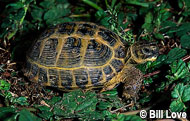Description:
The Russian tortoise is one of the most common tortoises in the pet trade today because it is currently heavily imported. Captive bred Russian tortoises are becoming more common as some of these imported groups become established. When the political situation with Russian was not as it is today the Russian tortoise was not often imported and as a result was not as common as it is today. Caution should be exercised when acquiring an imported Russian tortoise because they are usually stressed and heavily parasitized. A veterinarian visit is a must when a wild caught Russian tortoise is obtained. Russian tortoises make great pets because they are relatively small and very active in captivity. They are very cold tolerant but do not do well in cold and damp environments. They will develop respiratory problems rather quickly if kept under cool and damp conditions for any extended length of time although they do handle cool dry conditions very well at which time they will be inclined to hibernate. These tortoises are opportunistic feeders taking dark leafy greens and fibrous vegetables. Fruits such as pears and apples in addition to berries can be fed to add variety but should be fed sparingly. Russian tortoises will also take insects and carrion. A water dish with clean fresh water should be provided at all times although they do not use it very often seeming to get their hydration from their food.
Habitat:
Steppes (desert grassland) and rocky desert.
Range:
Iran, east to China, north to Russia, south to the Gulf of Oman and Pakistan.
Scientific Name: Testudo (Agrionemys) horsfieldii
Species Group: tortoise
Family: Testudinidae
Size: N/A
Level: beginner
Weight: 1 to 2 lbs
Dangerous: No



